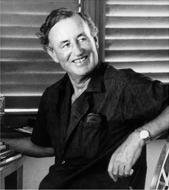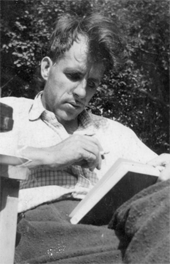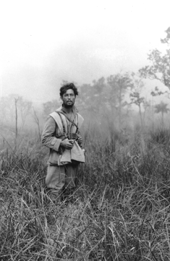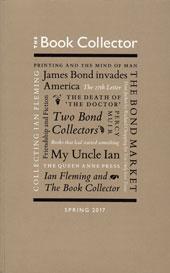Introducing our authors and their work |
||
|
Ian Fleming, creator of James Bond, was born in London on 28 May 1908. He was educated at Eton and later spent a formative period in Kitzbuhel, Austria, where he studied languages ( and made his first, tentative forays into fiction writing). In the 1930s he embarked on a career as a journalist with Reuters news agency. This was followed by a short and unsuccessful period in the City of London. He served throughout the Second World War as Assistant to the Director of Naval Intelligence, where his fertile imagination spawned a variety of covert operations, all of them notable for their daring and ingenuity. Although only an assistant, he was by virtue of that role, at the centre of wartime intelligence and the knowledge that he gained and about which he was under oath not to reveal, informed much of his later writing about James Bond. After the war he worked as foreign manager of the Sunday Times, a job that allowed him to spend two months each year in Jamaica. Here, in 1952, at his home ‘Goldeneye’, he wrote the first Bond novel Casino Royale which was published to immediate acclaim. Every year for the next twelve years. Fleming produced a new adventure featuring agent 007, one of the most famous literary characters of the century. He also found time to write two non-fiction books: The Diamond Smugglers, and Thrilling Cities as well as Chitty-Chitty-Bang-Bang, a much-loved children’s story about a magical car that flies. He lived to see the first two Bond films, Dr No and From Russia with Love. He died in 1964 aged fifty-six of a heart attack. His influence has been profound, leading to the astonishingly successful Bond film franchise – 23 films to date – and giving rise to many imitators in the thriller writing genre, as well as making the names of his characters, not only James Bond but also the villains he contends with, known the world over. The complete edition is presented in three different bindings. Please click here for details.
Peter Fleming was a distinguished writer: special correspondent for The Times, columnist and reviewer for the Spectator, author of travel books before the war, and historical works after. He was the older brother of Ian Fleming, creator of James Bond. Educated at Eton College and Oxford, Peter Fleming was editor of the Eton College Chronicle, and also Isis at Oxford. He joined the Spectator as literary editor shortly after leaving Oxford, and it was from there at the age of 24 that he replied to an advertisement: ‘Exploring and sporting expedition leaving England June, to explore rivers Central Brazil, if possible ascertain fate of Colonel Fawcett.’ This would lead to his first travel book, Brazilian Adventure, published in 1932. In 1935 he made an even more extraordinary journey travelling with a Swiss companion, Ella Maillart, from Peking to Kashmir through disputed territory and difficult terrain. This resulted in News From Tartary published in 1936. During the Second World War, Fleming served initially with the Grenadier Guards before being commissioned to help establish the auxiliary units that would fight on, behind enemy lines, in the event of invasion by Germany. Invasion 1940 (also called Operation Sealion) was his account of those plans. His principal service, however, from 1942 to the end of the war, was as head of ‘D’ Division, in charge of military deception operations in Southeast Asia. During the 1950s and 1960s Fleming returned to journalism with a column in the Spectator, a frequent contributor of the light-hearted Fourth Leader for The Times, and much else. He wrote accounts of specific historical events that had taken place in lands through which he had travelled. As Dr Nitt-Pick, he gave his brother Ian stylistic advice on his new James Bond novels. He inherited from his grandfather, Robert Fleming, founder of the London merchant bank of that name, land in Oxfordshire, and he became closely involved in the care and upkeep of the farm and the woodland. He was at work on a history of deception in the second world war when he died suddenly of a heart attack, seven years after his brother, Ian. For more details of the books, click here.
Mervyn Peake was born on 9 July 1911 in the Chinese hill-station of Kuling to medical missionary parents. He was educated at Tientsin Grammar School, Eltham College, Kent and the Royal Academy Schools in London. A precocious artist, whose drawings were first published at the age of eleven, he went on to become one of Britain’s most notable illustrators providing material for classics such as The Ancient Mariner, Alice In Wonderland, Treasure Island and The Hunting Of The Snark. In addition, he was a playwright, an award-winning poet and the author of several childrens’ books. He is best known, however, for the ‘Gormenghast’ trilogy, an extended fantasy revolving around Titus Groan, 77th Earl of the crumbling castle Gormenghast. Published between 1946 and 1959 the trilogy received critical acclaim but sold poorly. Only after his death did his work achieve the cult status that it has maintained ever since. His last years were blighted by the early onset of Parkinson’s Disease from which he died in 1968. Letters from a Lost Uncle and Captain Slaughterboard Drops Anchor are two books Peake wrote and illustrated for children. Presented afresh by Libanus Press and printed in four and two colours respectively. Poems is a collection of Peake’s published verses, reproduced chronologically by volume up to and including Collected Poems (2008) edited by Rob Maslen. Where Peake provided illustrations we have included them. Where not we have added appropriate images from the archive. This is the most comprehensive single-volume collection to date. Labyrinth is a new title comprising the short stories previously published in Boy in Darkness (2007) with the addition of ‘Mr Slaughterboard’ and ‘Touch ‘O The Ash’ from Peake’s Progress (1981). The title is taken from an episode in Gormenghast which struck Peake so forcibly that he illuminated the MS with a burst of labyrinth-themed drawings and even a potential cover illustration. It was as if he was contemplating an entirely new book – and so, with the Peake Estate’s permission, we have taken the liberty. In Umbra is another new title, a biographically-arranged compilation that combines familiar pieces from Peake’s Progress with unseen or little-known items from the archive. It starts with Peake’s first published work, an illustrated piece written in 1922 for a missionary magazine, and ends with ‘Foot-Fruit’, a verse/narrative that is believed to be his last creative work. In between there are sections containing illustrations from the unpublished ‘Moccus Book’ of 1929; a selection of his work as a war artist; a section devoted to the Gormenghast trilogy that includes the original title pages, drawings of discarded characters, sets for an abortive Gormenghast opera, and glimpses of future Titus adventures; plus an abbreviated short story ‘Johnny Butterfield’. As with Labyrinth the title is influenced by the MS: Peake’s working title for Gormenghast was ‘Titus In Umbra.’ We thought the abbreviation In Umbra was an apt description of these fragments which have hitherto been overshadowed by Peake’s more famous works. The Sunday Books. At weekends, while the family lived on Sark, Peake would tell stories to his sons Sebastian and Fabian. With each story he painted a picture in their notebooks. The stories are, alas, forgotten but the pictures are reproduced here in full colour with an introduction by Fabian Peake. As distinct from the recent ‘Sunday Books’ written by Michael Moorcock For full details, click here.
Dylan Thomas was born in Swansea in Wales in 2014. In his short life – he died in New York in November 1953 – he became very popular for his stories, his broadcasts and his poetry. Although distinctly a Welsh writer, he remains long after his death much loved as a poet and wordsmith all over the world. He began his career as a journalist, though he had already had poems published when he was a teenager. In the 1930s he caught the attention of the literary world, and in the 1940s to help make ends meet he took to broadcasting. Alcoholism and erratic behavior took their toll and led to his early death at the age of 39 not many months after the first broadcast performance of his ‘play for voices’ Under Milk Wood, arguably his most memorable and lasting work. For full details, click here.
Jon Gilbert is the foremost expert on the works of Ian Fleming. He is a renowned bookdealer at rare book experts Adrian Harrington Limited in London and has an encyclopaedic knowledge of Fleming’s works. He explains: “Ian Fleming is best known as the creator of James Bond, an icon of 20th century popular culture, but he was also a journalist, publisher, travel writer, motor enthusiast, card player, accomplished golfer and noted bibliophile. Much has been written about Fleming and his legendary creation, but until now there has been no serious bibliographical account of his published work.” For further details, click here
John Pearson was born in 1930 and worked for The Economist, BBC television and The Sunday Times (where he was assistant to Ian Fleming) before becoming a full-time author. He has written numerous works of fiction including Gone to Timbuctoo (1962), which won the Authors’ Club First Novel Award, and James Bond: The Authorised Biography of 007 (1973). He has also written several acclaimed works of non fiction ranging from The Life of Ian Fleming: Creator of James Bond (1966) and The Profession of Violence (1972), a biography of the Kray twins, to The Gamblers (2005), an account of London’s shady highlife and the mystery of Lord Lucan. His books have been adapted frequently for film and television. For further details, click here
In 1952, the year he wrote Casino Royale, Ian Fleming launched a quarterly periodical for bibliophiles: The Book Collector. Published originally by Queen Anne Press it was soon hailed as the most important journal of its kind in the world. After Fleming’s death in 1964, followed a year later by that of its founding editor John Hayward (friend and muse of T.S. Eliot), it was owned and edited until 2016 by Nicolas Barker. Still flourishing today under the editorship of James Fergusson it is now managed by Ian’s nephews James and Fergus Fleming. Authors featured in Ian Fleming: The Book Collector Nicolas Barker took over from John Hayward as Editor of The Book Collector, 1965-2016, and is a former Deputy Keeper at the British Library. John Cork is a film-maker and co-author of James Bond: the legacy (2002) and James Bond Encyclopedia (2007). A.S.G. Edwards is Professor of Medieval Manuscript Studies at the University of Kent. James Fergusson is proprietor of James Fergusson Books & Manuscripts and Editor of The Book Collector. Fergus Fleming is co-publisher of Queen Anne Press; he is the author of several non-fiction books and editor of The Man with the Golden Typewriter: Ian Fleming’s James Bond Letters (2015). James Fleming became proprietor of The Book Collector in 2016; erstwhile publisher of Alexander Heriot Books, he is also the author of five novels. Mirjam M. Foot is Emeritus Professor of Library and Archive Studies at University College London. Jon Gilbert is an antiquarian bookseller with Adrian Harrington Rare Books and author of Ian Fleming: the Bibliography (2012). Sheila Markham is Librarian at the Travellers Club and Brooks Club, London and is a regular contributor to The Book Collector. Joel Silver is Director of the Lilly Library, Indiana University. For further details, click here |
||
© Queen Anne Press 2020 l Home l Legal l Privacy policy | Cookies l Contact |
||||
l Site by Christopher Kent |
||||
Home >> Authors>>


Ian Fleming at Goldeneye, Jamaica.

Mervyn Peake in the 1950s.

Peter Fleming in 1931. The furthest point in the quest for Colonel Fawcett in Brazil.

The Spring 2017 edition of The Book Collector magazine devoted to Ian Fleming on the 65th Anniversary of the magazine's birth.






